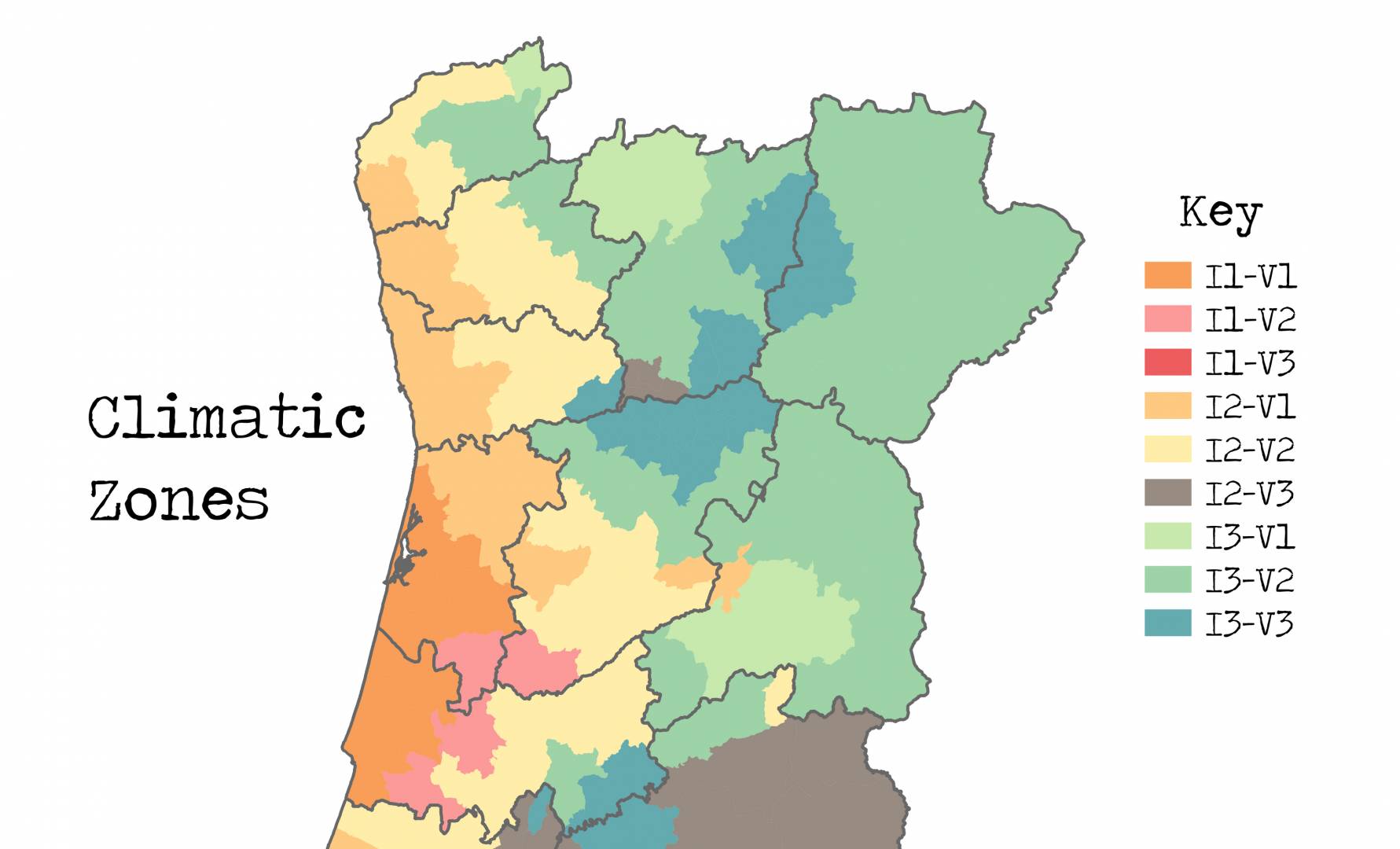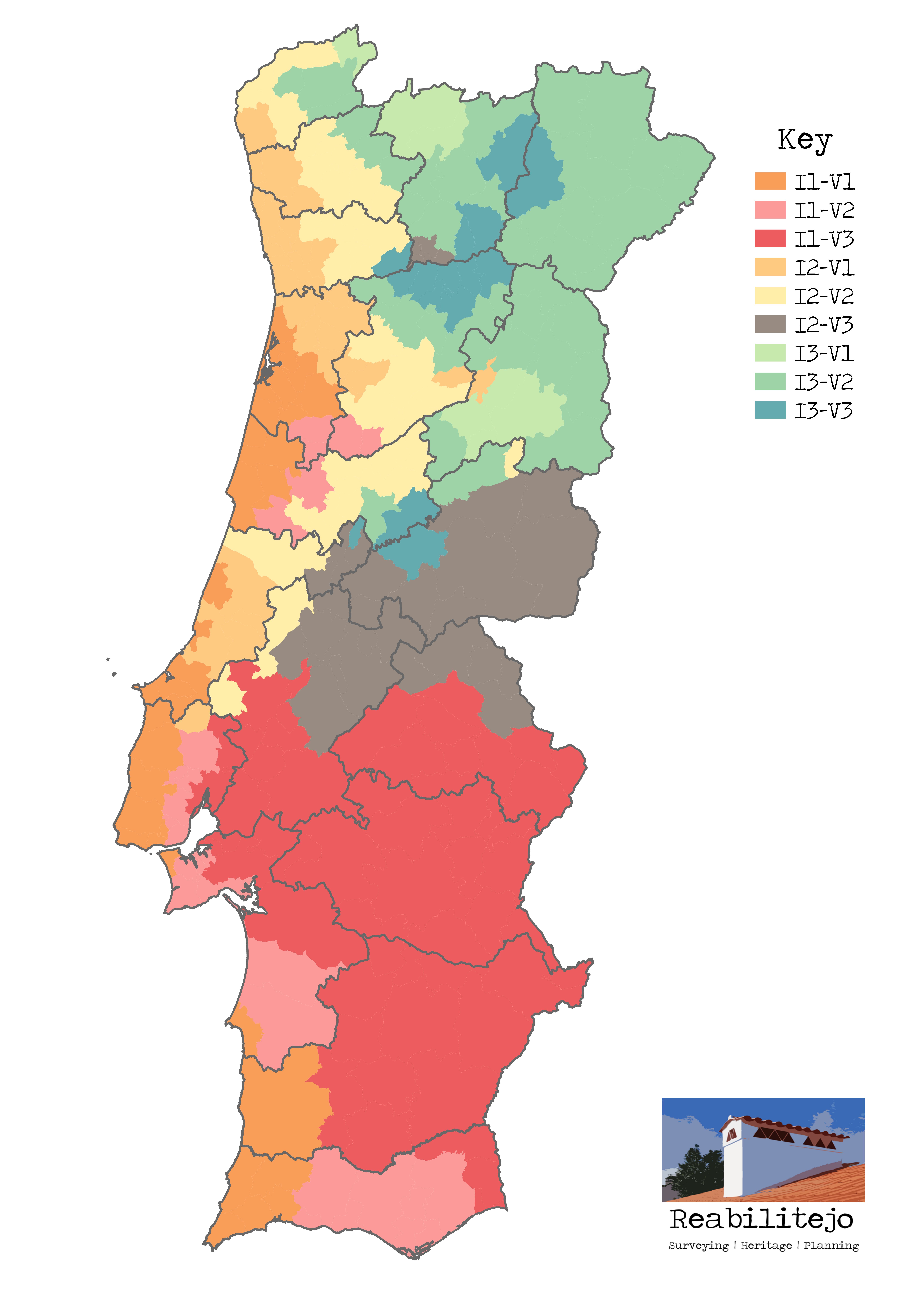
Climatic Zones in Mainland Portugal
Climatic Zones in Mainland Portugal
We all want a bit of comfort from our homes, and some consistency in being able to withstand Portugal’s wide temperature variations.
The first step is knowing our microclimate. Each part of the country is classified by distinct climatic zones depending on the intensity of summer and winter temperatures.
Winter is represented by the letter I (inverno), divided into I1, I2 and I3, with I3 indicating the most severe winters.
Likewise, summer is represented by the letter V (verão), again divided into V1, V2 and V3, with V3 experiencing the most extreme summers.
Each municipality in Portugal is categorised by both winter and summer codes, producing a possible 9 combinations, from I1-V1, with the most consistent year-round temperatures, to I3-V3, with the most extreme variations.
Reabilitejo has combined all this data into one map, so you can start to understand your area.
Read on beneath the map, to find out more, and clarify which combination your municipality falls under.

What and where are the different climate zones?
I1-V1
These areas have the mildest climates in mainland Portugal due to the stabilising maritime influence. It is important to fit buildings with adequate levels of insulation.
Glazed areas must be fitted with effective shading.
This area includes: Águeda, Albergaria-a-Velha, Aljezur, Almada, Amadora, Aveiro, Bombarral, Caldas da Rainha, Cantanhede, Cascais, Estarreja, Figueira da Foz, Ílhavo,
Lagos, Lourinhã, Mafra, Marinha Grande, Mira, Monchique, Montemor-o-Velho, Murtosa, Nazaré, Óbidos, Odemira, Oeiras, Oliveira do Bairro, Ovar, Peniche, Portimão,
Sines, Sintra, Torres Vedras, Vagos, Vila do Bispo.
I1-V2
Here, the maritime influence softens climatic extremes to some extent. Summer is more challenging than winter, so building styles and fittings should ensure protection
from the sun’s radiation. It is important to fit adequate levels of insulation. Glazed areas must be fitted with very effective shading.
This area includes: Albufeira, Alenquer, Anadia, Arruda dos Vinhos, Barreiro, Coimbra, Faro, Grândola, Lagoa, Lisboa, Loulé, Loures, Mealhada, Moita, Mortágua, Odivelas,
Olhão, Santa Comba Dão, Santiago do Cacém, São Brás de Alportel, Seixal, Sesimbra, Setúbal, Silves, Sobral de Monte Agraço, Soure, Tavira.
I1-V3
Summer conditions override winter conditions, so special care must be taken in restricting solar gains. Ensuring strong thermal inertia is also very important in the face
of extreme temperatures. It is important to fit buildings with high levels of insulation. Glazed areas must be fitted with highly effective shading.
This area essentially covers the inland Alentejo, and includes: Alandroal, Alcácer do Sal, Alcochete, Alcoutim, Aljustrel, Almeirim, Almodôvar, Alpiarça, Alter do Chão, Alvito,
Arraiolos, Arronches, Avis, Azambuja, Barrancos, Beja, Benavente, Borba, Campo Maior, Cartaxo, Castro Marim, Castro Verde, Coruche, Crato, Cuba, Elvas,
Entroncamento, Estremoz, Évora, Ferreira do Alentejo, Fronteira, Golegã, Mértola, Monforte, Montemor-o-Novo, Montijo, Mora, Moura, Mourão, Ourique, Palmela, Ponte
de Sôr, Redondo, Reguengos de Monsaraz, Salvaterra de Magos, Santarém, Serpa, Sousel, Vendas Novas, Viana do Alentejo, Vidigueira, Vila Franca de Xira, Vila Real de
Santo António, Vila Viçosa.
I2-V1
The maritime influence softens summer temperatures, but winter is harsher than summer, and buildings should be designed to ensure a greater capacity for gains in
solar radiation. It is important to fit buildings with high levels of insulation. Glazed areas must be fitted with effective shading.
Largely the north and central coast, this area includes: Alcobaça, Arouca, Barcelos, Batalha, Cadaval, Castelo de Paiva, Espinho, Esposende, Santa Maria da Feira, Fornos
de Algodres, Gondomar, Leiria, Maia, Matosinhos, Oliveira de Azeméis, Oliveira de Frades, Paredes, Penalva do Castelo, Porto, Porto de Mós, Póvoa de Varzim, São João da Madeira,
Sever do Vouga, Trofa, Vale de Cambra, Valongo, Viana do Castelo, Vila do Conde, Vila Nova de Famalicão, Vila Nova de Gaia, Vouzela.
I2-V2
This zone is essentially a zone of transition between the north and central coast and the interior, in a narrow band parallel to the coast. It is important to fit buildings with
high levels of insulation. Glazed areas must be fitted with very effective shading.
This area includes: Alcanena, Amarante, Amares, Ansião, Arganil, Belmonte, Braga, Carregal do Sal, Celorico de Basto, Condeixa-a-Nova, Fafe, Felgueiras, Guimarães,
Lousa, Lousada, Mangualde, Marco de Canavezes, Miranda do Corvo, Monção, Nelas, Oliveira do Hospital, Paços de Ferreira, Penacova, Penafiel, Penela, Pombal, Ponte de
Lima, Póvoa do Lanhoso, Rio Maior, Santo Tirso, São Pedro do Sul, Tábua, Tondela, Valença, Vila Nova de Cerveira, Vila Nova de Ourém, Vila Nova de Poiares, Vila Verde,
Viseu, Vizela.
I2-V3
The difference between this and Zone I1-V3 is the greater need for heating in winter due to the more northerly latitudes. It is important to fit buildings with very high levels
of insulation. Glazed areas must be fitted with highly effective shading.
Almost entirely found in the Beira Baixa and Alto Alentejo, this area includes: Abrantes, Alvaiázere, Borba, Castelo Branco, Castelo de Vide, Chamusca, Constância, Ferreira do
Zêzere, Figueiró dos Vinhos, Fundão, Gavião, Idanha-a-Nova, Mação, Marvão, Mesão Frio, Nisa, Pedrogão Grande, Penamacor, Peso da Régua, Portalegre, Proença-a-Nova,
Santa Marta de Penaguião, Sardoal, Tomar, Torres Novas, Vila de Rei, Vila Nova da Barquinha, Vila Velha de Ródão.
I3-V1
Winter is much harsher than summer, and as such, it is helpful to make maximum use of glazed areas facing south. It is important to fit buildings with extremely high levels
of insulation. Glazed areas must be fitted with effective shading.
This zone includes: Boticas, Celorico da Beira, Guarda, Manteigas, Melgaço, Montalegre.
I3-V2
Winter is very demanding, though summer should not be overlooked. It is important to fit buildings with extremely high levels of insulation. Glazed areas must be fitted with
very effective shading.
This zone includes: Aguiar da Beira, Alfândega da Fé, Almeida, Arcos de Valdevez, Bragança, Cabeceiras de Basto, Carrazeda de Anciães, Castro de Aire, Chaves, Cinfães,
Covilhã, Figueira de Castelo Rodrigo, Freixo de Espada à Cinta, Gois, Macedo de Cavaleiros, Meda, Miranda do Douro, Mogadouro, Mondim de Basto, Murça, Paredes de
Coura, Penedono, Pinhel, Ponte da Barca, Ribeira de Pena, Sabugal, Sátão, Seia, Sernancelhe, Terras de Bouro, Torre de Moncorvo, Trancoso, Vieira do Minho, Vila Flor,
Vila Nova de Foz Côa, Vila Nova de Paiva, Vila Pouca de Aguiar, Vila Real, Vimioso, Vinhais.
I3-V3
These are areas of extreme variations in temperature; with harsh winters and sweltering summers, so dwellings must be designed to cope with this. It is important
to fit buildings with extremely high levels of insulation. Glazed areas must be fitted with highly effective shading.
This zone includes: Alijó, Armamar, Baião, Castanheira de Pêra, Lamego, Mirandela, Moimenta da Beira, Oleiros, Pampilhosa da Serra, Resende, Sabrosa, S. João da
Pesqueira, Tabuaço, Tarouca, Valpaços.
For more detailed, specific advice regarding how to ensure the property you are researching, buying or restoring responds well to the climatic zone in which it is located, talk to Reabilitejo.
Find us at
linkedin.com/company/reabilitejo
Reach out to us via
info@reabilitejo.pt
Article by Reabilitejo – Official Surveying, Heritage and Planning Partner to KipperTree.
